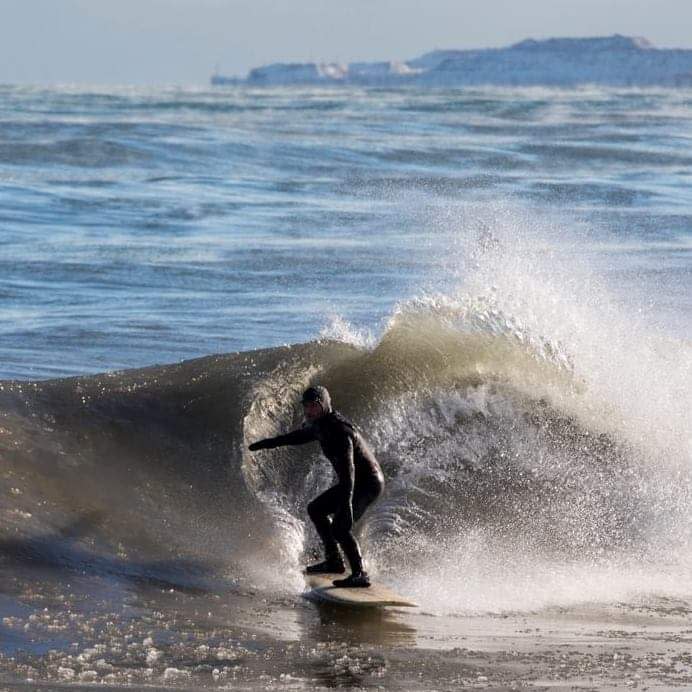But it’s not easy. The Great Lakes are big: five lakes, eight states and two countries. And to make matters more complicated, federal, state and local agencies all control beaches on the Great Lakes, and have their own set of measures to prevent drownings.
The result: a patchwork of red flag warnings, swim-at-your-own risk signage, rip-current warning signs, buoys for designated swimming areas and in some cases, lifeguards.
And yet, there are drownings every year in the Great Lakes – more than 1,200 since 2010, or an average of 100 a year, according to statistics compiled by Benjamin and the Great Lakes Surf Rescue Project, a nonprofit that he co-founded after surviving in a drowning while surfing in Lake Michigan the day after Christmas 2010.

Benjamin’s efforts to bring back lifeguards have taken the Illinois resident and surfer to one small community in Michigan: South Haven. But the skirmish over lifeguards on just two Lake Michigan beaches, which straddle the Black River as it empties into Lake Michigan, shows just how difficult it is to bring lifeguards to beaches − and South Haven is just one tiny spec on the Great Lakes.
The issue of lifeguards raises many questions: costs, liability, labor shortages. But there’s no question that a beach with lifeguards is safer than one without, says Adam Katchmarchi, CEO of the National Drowning Prevention Alliance, a non-profit based in Tustin, California.
Advocates, who have been fighting for lifeguards in South Haven for two decades, say they’ve made some progress this year with the South Haven City Council, which will be presented with information about starting a lifeguard program at an April 15 meeting.
The information packet will include the names of consultants and their fees, sources of supplies such as whistles and walkie-talkies, and how to recruit lifeguards and “build a culture around a lifeguard program,” said Heather Welsh-Johnson, who compiled the information as director of the South Haven Ambassadors Program and Education, or SHAPE.


A vote is not expected at that meeting, which means it’s doubtful that there will be lifeguards on the beach in time for Memorial Day, should the council ultimately sign off on a lifeguard program. Welsh-Johnson said she’s hopeful to have lifeguards in South Haven sometime this summer.
Welsh-Johnson said the last summer that South Haven had lifeguards was in 2001. Since then, there have been 12 drownings. The South and North beaches each have a pier, as well as sand bars, which makes them especially prone to structural, longshore, and rip currents. Wind, waves, and incoming storms add to the list of dangers in South Haven.
Beach visit ends in tragedy
Emily MacDonald and her boyfried, Kory Ernster, drowned in South Haven in August 2022. Both honors students, Ernster, 22 and a native of Novi, had just graduated from Michigan State University and taken a job in Wisconsin. MacDonald, 19, had just finished her first year at MSU. They were in South Haven for a vacation with the Ernster family and had talked about spending the rest of their lives together.
It was an overcast day and there were other people on the beach and in the water at South Beach when Emily and Kory went for a swim. A current carried them toward a pier, and within minutes, they were pulled under. A bystander pulled Emily out of the water and went back for Kory. Neither regained consciousness.


“It’s so sad. They loved the water and the water took them,” said mother Lisa MacDonald of Chesterfield Township.
MacDonald joined the effort to bring lifeguards to South Haven after the drownings and said the city has refused to listen to the experts for decades. This year, she said, “we’ve been relentless and we’re just not letting up.”


‘The money is there’
She said South Haven lures tourists with B&Bs, restaurants, and its beautiful beaches, and city officials “know they are on a dangerous, unsafe lake.”
And lifeguards, in turn, should be the city’s responsibility as it collects revenues from tourists who park in the beach-front lots, she said.
“The money is there,” she said. “They could do it if they made it their priority. This isn’t rocket science. They don’t have to reinvent the wheel.”
The Free Press left messages for the city manager and a member of the council, which were not returned. A second city council person reached by phone hung up on the reporter after she identified herself and the reason for the call.
The federal Centers for Disease Control and Protection says drowning is a serious public health threat and can happen in seconds, often quietly. It estimates that 4,000 people drown a year, or 11 a day. There are another 8,000 emergency room visits, or 22 a day, for non-fatal drownings, which can cause brain damage and other serious outcomes.
More than half of fatal and non-fatal drownings among people 15 and older occur in natural waters such as lakes, rivers, and oceans. Drowning is the leading cause of death for children ages 1-4, and the second-leading cause for children 5-14, after motor vehicle accidents, according to the CDC.
Katchmarchi, of the drowning prevention alliance, said no one single element will prevent drownings – life jackets, parental supervision, an the ability to swim all matter. And while they’re not foolproof, lifeguards “absolutely, and unequivocally” add a level of protection.
“A lifeguard environment is a safer environment,” Katchmarchi said.
He said he doesn’t understand why beachside communities that benefit from tourism fail to provide visitors with the protection of lifeguards, especially in places like the Great Lakes, with their waves, currents, and rapidly changing weather.
Lifeguards, he said, “help make sure everyone gets home at the end of the day.”
Contact Jennifer Dixon: jbdixon@freepress.com
This article originally appeared on Detroit Free Press: Expert says lifeguards make a beach safer but it can be a tough sell
